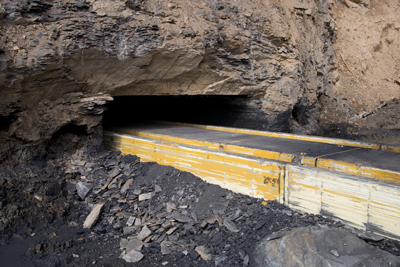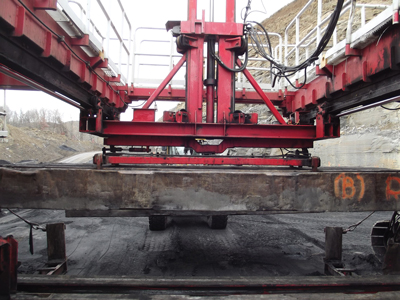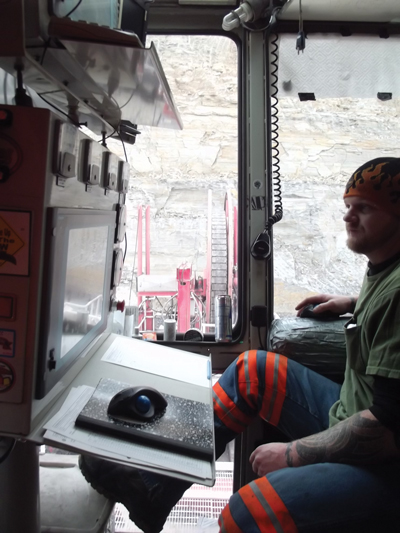SAFETY, VERSATILITY, PRODUCTIVITY AT THE HEART OF EASTERN OHIO HIGHWALL
By Donna Schmidt, Field Editor
Highwall mining: by many it’s still considered on the fringes of being a viable, high production coal miner. But for those who know and use it, like contract miner Commonwealth Mining, it provides the safety standards and financial results that are helping grow their business and build their reputation.
It wasn’t long ago that many surface miners would abandon a site, effectively leaving money on the table, because the remaining resource was just too complex and too costly to recover. The mine reached the economic limits dictated by the effective shipping ratio — the visible coal was left in the highwall face.
It has taken some time — highwall technology has a global history stemming back to the late 1970s, but only began catching on in popularity in the U.S. in the 1990s — but the highwall miner now has a healthy share of space in the mining market for many reasons. This includes its versatility, its ability to extract the still-valuable tonnage many had long written off, and its development as a viable and low-cost mining option that keeps workers safe by keeping them away from the bench and behind the miner’s controls.
One of the producers benefiting from highwall mining is Oxford Resource Partners, Ohio’s largest mining company with 6 million tons of production annually and a portfolio with more than 81 million tons of proven and probable reserves not yet tapped. Among those operations in their prime is the East Canton highwall complex in Stark County, a former Oxford surface mine that now uses a Caterpillar HW300 (No. 36 in Cat’s currently active fleet of 83) to extract 4,500 tons per week (tpw) from the No. 6 seam that measures an average height of 28 in. (due to current market conditions, Oxford mandates only one entry can be mined per day). Still, not bad for a self-contained mining machine that measures 66.5 ft in length, 28.7 ft in height and 38.5 ft in width.
AN IDEAL LOCATION
 The Commonwealth mining team averages 4,000 tons per week from the East Canton site.
The Commonwealth mining team averages 4,000 tons per week from the East Canton site.The East Canton site is an exemplary location for a highwall operation: former surface property with a reserve not large and cost-efficient enough for extraction using underground methods, with no more than 200 ft of overburden, competent coal and geology, and relatively flat seams with no faults.
East Canton started mining in April with the Cat HW300, and now has an average team of four crossing Appalachia from their homes to log two-week shifts aboard the miner, maintaining the unit and its associated fleet, managing coal transport or controlling the miner from a cab high above the power-head moving the cutter head up to 1,000 ft into the mountain and the conveyor system bringing coal out as fast as it can be mined. When the seam is mined out sometime in mid-2015, it will have taken approximately 240,000 tons of coal at an average rate of 4,000 tpw.
Serving as a contract miner at East Canton is West Virginia-based Common-wealth Mining; the firm has a long-standing partnership with Oxford and currently serves as operator for two highwall mines across the state (its sister mine, the “No. 73,” is in Rayland, Jefferson County) and another in Kentucky (Highwall Miner No. 61). Leading the charge at Commonwealth are President Stuart Cox and General Superintendent Sam Hendrick, both of whom praise their Stark County team for their commitment to safe, productive operations.
In the case of Highwall Miner No. 73, Commonwealth is mining an average seam height of 44 in. and is equipped to mine depths up of 1,340 ft. Production consistently averages 2,100 linear ft per 12-hour shift.
That’s all perfect by Cat standards; its HW300s produce an average of 120,000 tpm in coal seams and the business end of the unit ideally aims for recovery of 70% of in-place coal. The HW300 can also handle dipping seams of (plus or minus) 8˚ and can operate on contour benches as narrow as 65 ft (18 m).
“The team has put together some updates with the latest technologies as this [HW300] highwall mining system evolves, and the core group — they’ve been with us for several years — they’re the best in the business,” Cox said.
The team also receives a high level of OEM support from Cat, as noted by HW300 Commercial Manager JD Fairchild. The longtime highwall miner application specialist noted that Oxford is one of many operators that employ multiple highwall miners due to their sound investment potential and rapid capital return, particularly when coal is not performing at its peak.
“Customers will choose this system for two overriding reasons, safety and revenue generation. The HW300 automates a great deal of its operation, so crews can be limited to three or four people per shift. That’s a safety advantage. The machine’s production capability — like being able to mine material in less-than-ideal conditions — is just one reason why this machine is so cost effective,” Fairchild said.
BUILDING THE BEAST: THE HW300
 The Cat HW300’s power head and push beams move the cutter head up to 1,000 ft into the mountain.
The Cat HW300’s power head and push beams move the cutter head up to 1,000 ft into the mountain.The No. 36, as Commonwealth and Cat refer to it, is not the company’s newest miner sent out the factory doors, but it is certainly advanced in its design and specifications and ready to take on every whim of its crew.
The bench before a highwall is, by design, not the most spacious of areas, but the HW300 can fit on benches of only 65 ft and tram easily between entries, with a reel and steel-armored chain that protects the inner components including power cables, cutter control cable and coolant lines.
The miner’s cutter module (four sizes are available) is pushed into the seam by a series of push beams, also known as unmanned coal-conveying elements, that get the head to the back of the drive, and the extracted coal can be sent back to crews via an optional right-angle conveyor system or a stacking conveyor system, where coal is moved to the center of the bench for the stockpiling of larger volumes. The unit’s hydraulically powered tracks can articulate independently in two operating modes, mine mode and tram mode, and the set of four can rotate the machine 360° as needed, allowing for needed maneuverability.
As Fairchild noted, a common question from potential customers is how the miner or the operator knows when what’s being cut is all coal. The answer starts with the operator monitoring cutter head amperage as it travels forward. This is the most common method; however, an optional gamma detection system, which can be used to guide the cutter module through the coal seam and leave predetermined amounts of coal in the roof and floor also permits easier coal mining in soft roof and/or soft floor environment.
The operator, protected from the elements in the miner’s pressurized cab, has a full view of the operation, the highwall itself and the touchscreen monitoring systems logging every movement in the bench. In addition to the GDS, the Cat HW300 also has an optional solid-state, fiber-optic, gyro-based navigation and steering system (FOG) that offers real-time cutter module location data in real time.
Using a programmable logic controller (PLC), a highwall operator can also view comprehensive diagnostics, including troubleshooting and maintenance assistance, to help keep uptime percentages as high as possible.
Another common inquiry from would-be highwallers is how the unit keeps steady with pinpoint parallel accuracy. In the case of the Cat HW300, an anchoring system with two front-mounted drills can sink up to 8 ft into the pit floor to stabilize the machine, keeping it exactly in its place even while working at its hardest; the machine has a maximum push in of 136 tons and pull out of 276 tons.
East Canton’s highwall miner has the above plus another feature Cat considers optional equipment: a push beam grapple, a tool to make push beam transportation and placement of one of the 49 beams in the system much more safe and with much less headache.
At the heart of all HW300s is their power, which can come from either highline power or diesel generator for more remote locations. East Canton’s diesel generator has a 1,500-kW output, keeping the miner running full steam ahead.
According to Fairchild, the biggest challenge with any highwall mining site is not the operation of the unit itself — it is, by far, the preparation process it takes to get to the point of bringing the mine into active status.
Once the miner is assembled and in place and the crew is ready to go, Cat dealers will provide training and support through the life of the project. In some cases, he added, some miners have reported a complete return on their investment in a short period time — not something ever easily done with either traditional surface or underground equipment.
THE LEGACY OF CAT’S HWM
 The HWM operator can see every aspect of the machine’s activity — and the movements of the crew — in real time from his position.
The HWM operator can see every aspect of the machine’s activity — and the movements of the crew — in real time from his position.Caterpillar has a long and storied reputation in the construction and mining world, but even with its relative youth, the Cat HW 300 highwall miner has had its own colorful path.
The machine was first designed by the R.S.V. Co. of Holland, which nearly abandoned it completely when the product had limited sales success. According to Cat, Paul van Es, a Dutchman with roots in the pile driving industry, was intrigued by the product and was confident he could give it a future, and thus took over the stock and traveled to America to see the machines in use.
While stateside, van Es connected with Steve Antoline, who would become his business partner, and together the two founded Superior Highwall Miners Inc. in 1994. The pair, who headquartered their company in the heart of Appalachia’s coalfields in Beckley, West Virginia, proceeded to disassemble the machine, rebuild it from the frame up using components they felt had proven track records and performance histories.
SHM, enjoying the growth of the highwall sector, was sold in 2006 to Tennessee Valley Ventures/Lehman Bros. and the next year became a part of surface equipment giant Terex.
Just three years later, Terex sold to Bucyrus, a portion of its business, which was in turn purchased by Cat in July 2011. Now labeled the Cat HW300, the unit was manufactured in Beckley through this past spring; it is now constructed at Cat’s Houston, Pennsylvania, manufacturing campus just outside of Pittsburgh.
GROWING THE HWM MARKET
Most of the HWMs are operating in the U.S., but that footprint is something Cat is hoping they can grow using their worldwide dealer network and support capability. Many of its domestic and international customers have multiple units in use, from three to as many as seven.
With average estimates of 40,000 tpm to more than 100,000 tpm, the potential of a highwall — particularly from a seam long forgotten and written off as having no value — makes the option an attractive one for many miners.
There are currently 76 machines operating in the U.S., and there are units cutting coal currently in Russia, Colombia and India. Cat also has a second HW300 going to a producer in India in the first quarter of 2015 with a brand new order for a customer in South Africa scheduled to ship in the third quarter of 2015. In the U.S., Appalachia is the preferred highwall home — there are approximately 62 active machines working in West Virginia, Virginia, Pennsylvania, Kentucky, Ohio and Maryland. Still others are cutting coal at operations in Alabama and Utah.
IS HIGHWALL MINING THE RIGHT CHOICE?
Another common question by prospective highwall miners, according to Fairchild, is how a company knows when the highwall option is a feasible one. The response is something into which Cat has put much thought. As a result, the OEM has developed a Web-based site evaluation tool to help mining companies determine if the geology and physical characteristics of a mine site can comfortably accommodate a Cat HW300 highwall miner.
Using a site’s geological data, including the strength of the immediate overburden, coal strength, dip, methane content, water inflow, average highwall angle and a series of other factors, the tool can aid in the highwall decision. A resulting grid will indicate whether the site is ready for a miner or if more information is needed. Cat stresses that it is a guide only and is not intended to be a definitive determination. The tool is available in multiple languages on its website.
There is, of course, a reason Oxford was so open to putting the Cat HW300 into service at East Canton. The highwall mining method has offered enviable records for safety as well as great returns for the producer.
In fact, recovery at the Stark County site is expected to be about 64% when the miner takes its last tons next year.
Additionally, neither Cox nor Hendrick are new to the highwall sector; both know the advantages of the method as well as how to keep a miner running at its best.
“The overall average hole depth [the company’s mine depth exceeds 1,000 ft] has been better than any Cat highwall miner to date, and we’ve been able to mine a low-ash coal seam successfully using gamma detection,” Cox said, adding that the mine has had zero lost-time accidents since its start.
“Our commitment to teamwork and safety motivates our employees to perform to the highest standard in the industry,” Hendrick added. “Common-wealth Mining has, in my opinion, the best people in the industry.”




